Statutes, created by the Texas legislature, recognize that contractors, subcontractors, vendors and suppliers needed a greater remedy for non-payment for their work than merely the right to sue on their contracts. In Texas we fortunately have a very generous amount of law dedicated to the lien claimants. The downside to having that much law is that it becomes more cumbersome to understand. Also Texas law is particularly unforgiving to subcontractors and suppliers whose notice letters or liens are untimely or improper.
A mechanic’s lien is a way to secure your interest in the title to a property where labor or materials were supplied to improve the property.
KMDA’s primary responsibility is to help our clients understand what they need to do to retain and protect their lien rights. KMDA has mastered the art of sending accurate and timely notice letters and liens with the least amount of hassle to the client at a reasonable price. KMDA also understands that just having a lien doesn’t do any good if you can’t collect on it. So we strive to draft our mechanic’s lien demands in a manner that give our clients the largest possibility to collect the debt. Additionally, we send out monthly emails to our mechanic’s lien clients to try and not only remind them of their upcoming deadlines but to inform them of some of the nuances in the mechanic’s lien law and educate them on ways to protect their receivables.
Probably the hardest part of the Lien process to get right is the verbiage that needs to be used in both the Notice of Lien letter and the Lien Affidavit. The trap a lot of subcontractors fall into is they have a form they use for filing all liens. Using a form is problematic because the forms floating out there on the internet are not always state specific and the verbiage used in the form doesn’t change. There are so many variables to making sure your notice letters and liens are filed correctly.
There is a lot of verbiage required by the Texas Property Code and it is all dependent on whether or not the property is considered Commercial or Residential and, to add more complication, whether it is considered a Homestead.
Where do I fall?
COMMERCIAL
NOTE: Look out for tenancy which is a different situation.
RESIDENTIAL CONSIDERED COMMERCIAL
-
- Trust
- Corporation – LLC or Inc.
- Builder who is building it to put on the market (spec)
COMMERCIAL TENANCY
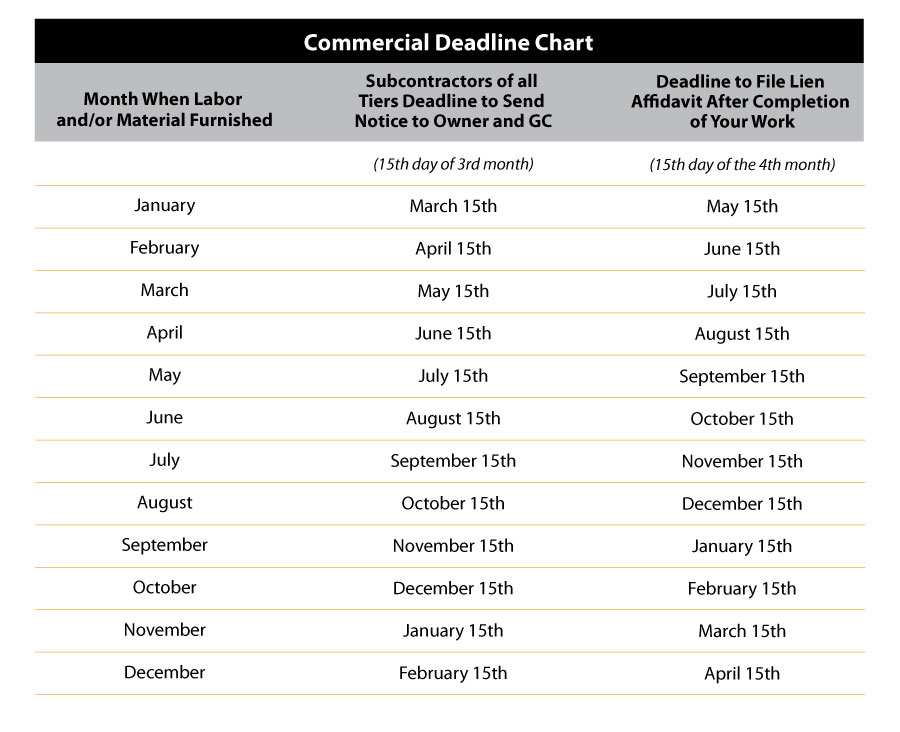
RESIDENTIAL
- Residential
- Duplex
- Condominium
- Townhome
CATEGORIES OF RESIDENTIAL
- Homestead
Properties that are lived in primarily by the Owner. If being built to live in, question often turns on if they still have a designated homestead that they are living in. - Non-Homestead
Properties that are not lived in primarily by the Owner, such as rental properties, 2nd homes, vacation homes, homes for ailing parents, etc.
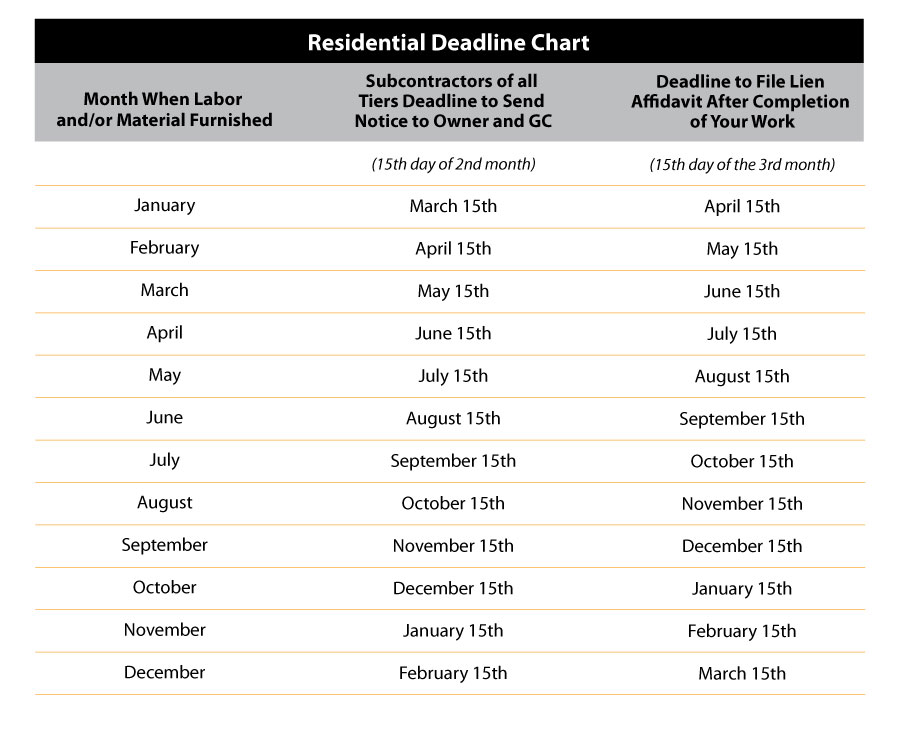
CONSTITUTIONAL LIENS
- In order to have a constitutional lien, you must directly contract with the property owner.
- You are not required to send any pre-lien notices such as is required in all of the other Statutory liens.
- Your best chance to be paid is to follow the Commercial Lien Deadline Chart. (seen here)
- If you miss that deadline, you can still file the lien within four years after the debt accruing.
- You cannot file it against an innocent purchaser of a property (meaning new owner).
- This can be for residential and commercial.
- The lien must have all of the normal formalities and must be sent to the parties as required by law.
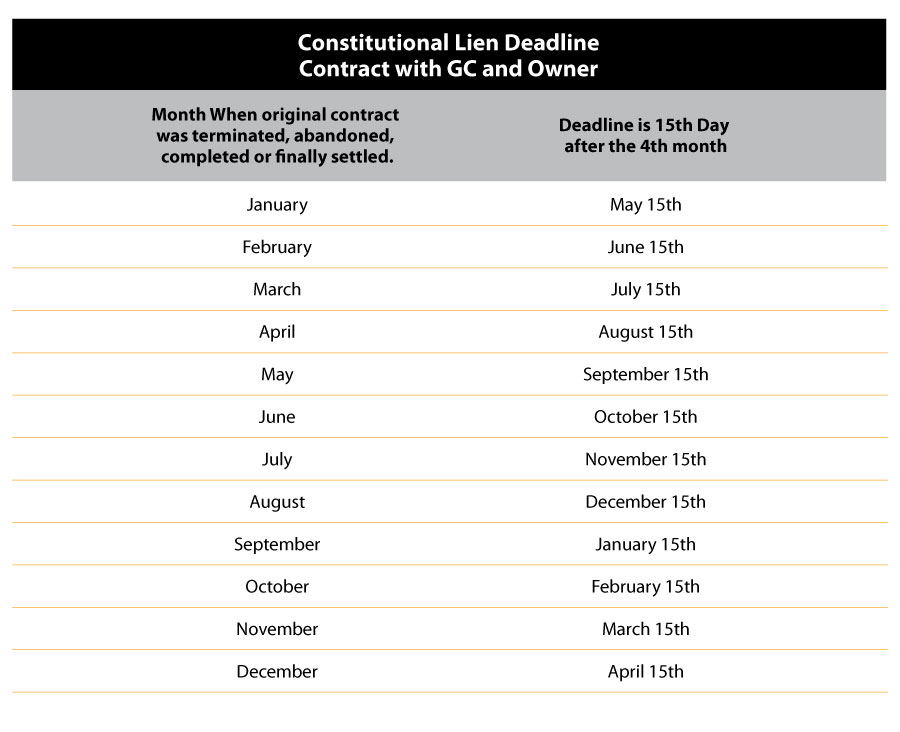
LIENS INCLUDING RETAINAGE
- There is no Pre-Notice Requirement.
- We typically send the retainage notice with the other notices.
- IF you are only seeking payment of retainage, you must send a notice within 30 days after the date the claimant’s contract is complete, terminated, or abandoned, or the 30th day after the date the original contract is complete, terminated or abandoned, whichever is earlier.
- The lien deadline for retainage claims can be very complicated and is based on several factors:
-
- Deadline is 15th day of the 4th month following its last month of work to file a lien on is retainage.
- However, if the owner sends the claimant notice of an affidavit of completion then the lien must be filed by the 40th day after the dated stated in the affidavit of completion.
- if the owner sends a written demand to the claimant for it to file a lien affidavit then the deadline is shortened to the 30th day after the date the owner sent the notice.
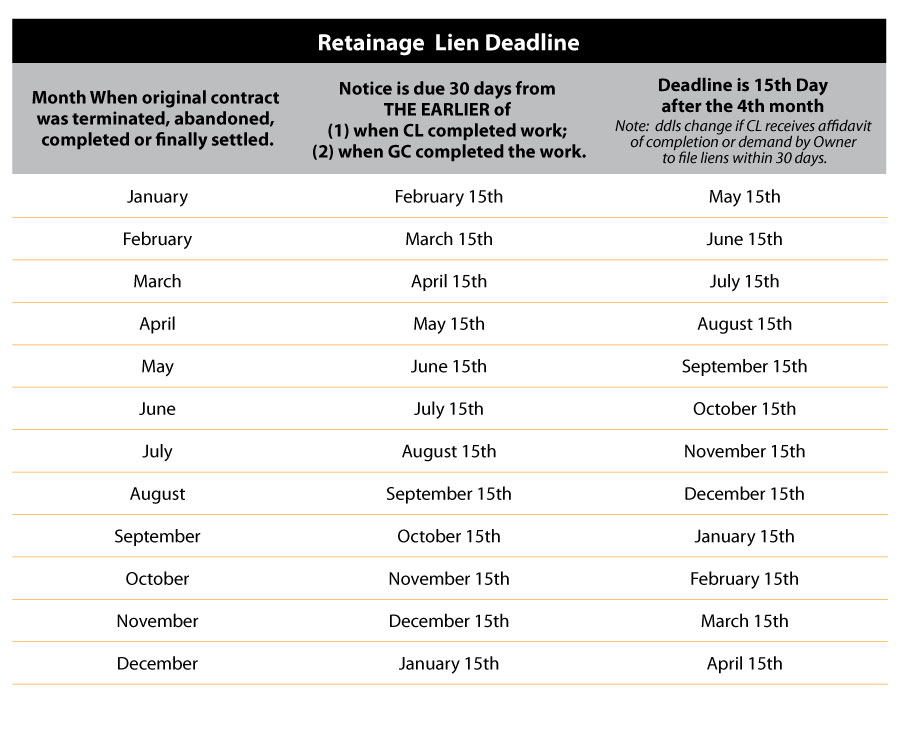
What does this mean to you, the person who is owed money? If you file an invalid lien on a property, not only have you lost an essential means of collecting on your work, but you can also face extremely harsh legal penalties for doing so. In most cases, you might have to pay the property owner whatever their costs and attorney’s fees were incurred to remove the lien. Even more alarming, if your lien is found to be fraudulent under the Chapter 12 of the Texas Civil Practice and Remedies Code, you can be held liable for minimum damages in the amount of $10,000.00 plus court costs, reasonable attorney fees and exemplary damages in an amount determined by the court.
Very rare is the situation that a non-lawyer can file their own lien and perfect it correctly. Even more surprising is the amount of attorneys out there that file the occasional mechanic’s lien and, because they don’t do it as a primary part of their practice, they too are confused by the quagmire of the mechanic’s lien laws. Mechanic’s liens are a lot like a maze. You can start traveling down one path only to hit a dead end and have to turn around. Or, you can get really far in the process only to discover you took a wrong turn. KMDA takes the time to learn their clients’ business. This helps in trying to get the liens filed and perfected correctly.
Once you have a valid lien you need to decide how to proceed to try and recover the money owed. The most common option is to just leave the lien filed and attached to the property and hope the owner tries to sell or refinance the property. However, in the age of foreclosures and bankruptcies, the often smarter option (depending on the amount of controversy) is to foreclose on the property and sue the person you contracted with for breach of contract. Recent changes to the law, such as the Prompt Pay Statute and Texas Trust Fund Act, have added a great deal more substance to collection efforts and have even provided a way to “pierce” the corporate veil and sue people personally if they improperly divert trust funds that were suppose to go to pay you.

CONTACT US
550 S. Edmonds Ln Ste 210
Lewisville, TX 75067
Phone:
972-434-8009
